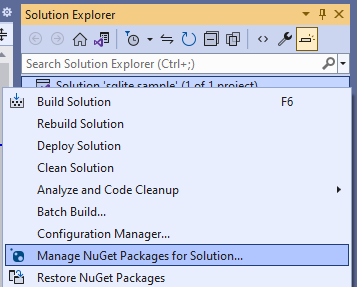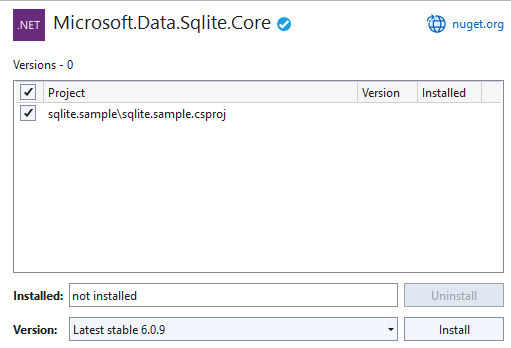Use a SQLite database in a UWP app
You can use SQLite to store and retrieve data in a light-weight database on the user's device. This guide shows you how.
Some benefits of using SQLite for local storage
✔️ SQLite is light-weight and self-contained. It's a code library without any other dependencies. There's nothing to configure.
✔️ There's no database server. The client and the server run in the same process.
✔️ SQLite is in the public domain so you can freely use and distribute it with your app.
✔️ SQLite works across platforms and architectures.
You can read more about SQLite here.
Choose an abstraction layer
We recommend that you use either the Entity Framework Core or the open-source SQLite library built by Microsoft.
Entity Framework Core
Entity Framework (EF) is an object-relational mapper that you can use to work with relational data by using domain-specific objects. If you've already used this framework to work with data in other .NET apps, you can migrate that code to a UWP app and it will work with appropriate changes to the connection string.
To try it out, see Getting Started with EF Core.
SQLite library
The Microsoft.Data.Sqlite library implements the interfaces in the System.Data.Common namespace. Microsoft actively maintains these implementations, and they provide an intuitive wrapper around the low-level native SQLite API.
The rest of this guide helps you to use this library.
Set up your solution to use the Microsoft.Data.SQlite library
We'll start with a basic UWP project, and then install the appropriate Nuget packages.
All supported versions of Windows support SQLite, so your app does not have to package SQLite libraries. Instead, your app can use the version of SQLite that comes installed with Windows. This helps you in a few ways.
✔️ Reduces the size of your application because you don't have to download the SQLite binary, and then package it as part of your application.
✔️ Prevents you from having to push a new version of your app to users in the event that SQLite publishes critical fixes to bugs and security vulnerabilities in SQLite. The Windows version of SQLite is maintained by Microsoft in coordination with SQLite.org.
✔️ App load time has the potential to be faster because most likely, the SDK version of SQLite will already be loaded into memory.
Let's start by adding a class to your UWP project named DataAccess. You can use a .NET Standard class library project to contain your data access code, but we won't use one in our example.
Right-click the solution, and then click Manage NuGet Packages for Solution.

At this point, you have a choice. You can use the version of SQLite that is included with Windows or if you have some reason to use a specific version of SQLite, you can include the SQLite library in your package. We are going to use the version of SQLite that's included with Windows.
Choose the Browse tab, search for the Microsoft.Data.SQLite.Core package, and then install the latest stable version.

Add and retrieve data in a SQLite database
We'll do these things:
1️⃣ Prepare the data access class.
2️⃣ Initialize the SQLite database.
3️⃣ Insert data into the SQLite database.
4️⃣ Retrieve data from the SQLite database.
5️⃣ Add a basic user interface.
Prepare the data access class
Open the DataAccess class in your project and make that class static.
Note
While our example will place data access code in a static class, it's just a design choice and is completely optional.
public static class DataAccess
{
}
Add the following using statements to the top of this file.
using Microsoft.Data.Sqlite;
using System.Collections.Generic;
Initialize the SQLite database
Add a method to the DataAccess class that initializes the SQLite database.
public async static void InitializeDatabase()
{
await ApplicationData.Current.LocalFolder.CreateFileAsync("sqliteSample.db", CreationCollisionOption.OpenIfExists);
string dbpath = Path.Combine(ApplicationData.Current.LocalFolder.Path, "sqliteSample.db");
using (SqliteConnection db =
new SqliteConnection($"Filename={dbpath}"))
{
db.Open();
String tableCommand = "CREATE TABLE IF NOT " +
"EXISTS MyTable (Primary_Key INTEGER PRIMARY KEY, " +
"Text_Entry NVARCHAR(2048) NULL)";
SqliteCommand createTable = new SqliteCommand(tableCommand, db);
createTable.ExecuteReader();
}
}
This code creates the SQLite database and stores it in the application's local data store.
In this example, we name the database sqlliteSample.db but you can use whatever name you want as long as you use that name in all SqliteConnection objects that you instantiate.
In the constructor of the App.xaml.cs file of your UWP project, call the InitializeDatabase method of the DataAccess class.
public App()
{
this.InitializeComponent();
this.Suspending += OnSuspending;
DataAccess.InitializeDatabase();
}
Insert data into the SQLite database
Add a method to the DataAccess class that inserts data into the SQLite database. This code uses parameters in the query to prevent SQL injection attacks.
public static void AddData(string inputText)
{
string dbpath = Path.Combine(ApplicationData.Current.LocalFolder.Path, "sqliteSample.db");
using (SqliteConnection db =
new SqliteConnection($"Filename={dbpath}"))
{
db.Open();
SqliteCommand insertCommand = new SqliteCommand();
insertCommand.Connection = db;
// Use parameterized query to prevent SQL injection attacks
insertCommand.CommandText = "INSERT INTO MyTable VALUES (NULL, @Entry);";
insertCommand.Parameters.AddWithValue("@Entry", inputText);
insertCommand.ExecuteReader();
}
}
Retrieve data from the SQLite database
Add a method that gets rows of data from a SQLite database.
public static List<String> GetData()
{
List<String> entries = new List<string>();
string dbpath = Path.Combine(ApplicationData.Current.LocalFolder.Path, "sqliteSample.db");
using (SqliteConnection db =
new SqliteConnection($"Filename={dbpath}"))
{
db.Open();
SqliteCommand selectCommand = new SqliteCommand
("SELECT Text_Entry from MyTable", db);
SqliteDataReader query = selectCommand.ExecuteReader();
while (query.Read())
{
entries.Add(query.GetString(0));
}
}
return entries;
}
The Read method advances through the rows of returned data. It returns true if there are rows left, otherwise it returns false.
The GetString method returns the value of the specified column as a string. It accepts an integer value that represents the zero-based column ordinal of the data that you want. You can use similar methods such as GetDataTime and GetBoolean. Choose a method based on what type of data the column contains.
The ordinal parameter isn't as important in this example because we are selecting all of the entries in a single column. However, if multiple columns are part of your query, use the ordinal value to obtain the column you want to pull data from.
Add a basic user interface
In the MainPage.xaml file of the UWP project, add the following XAML.
<Grid Background="{ThemeResource ApplicationPageBackgroundThemeBrush}">
<StackPanel>
<TextBox Name="Input_Box"></TextBox>
<Button Click="AddData">Add</Button>
<ListView Name="Output">
<ListView.ItemTemplate>
<DataTemplate>
<TextBlock Text="{Binding}"/>
</DataTemplate>
</ListView.ItemTemplate>
</ListView>
</StackPanel>
</Grid>
This basic user interface gives the user a TextBox that they can use to type a string that we'll add to the SQLite database. We'll connect the Button in this UI to an event handler that will retrieve data from the SQLite database and then show that data in the ListView.
In the MainPage.xaml.cs file, add the following handler. This is the method that we associated with the Click event of the Button in the UI.
private void AddData(object sender, RoutedEventArgs e)
{
DataAccess.AddData(Input_Box.Text);
Output.ItemsSource = DataAccess.GetData();
}
We also want to be sure that any existing data is loaded when the application starts. Add a line of code to the MainPage constructor to call GetData().
public MainPage()
{
this.InitializeComponent();
Output.ItemsSource = DataAccess.GetData();
}
That's it. Explore the Microsoft.Data.Sqlite to see what other things you can do with your SQLite database. Check out the links below to learn about other ways to use data in your UWP app.
Next steps
Connect your app directly to a SQL Server database
See Use a SQL Server database in a UWP app.
Share code between different apps across different platforms
See Share code between desktop and UWP.